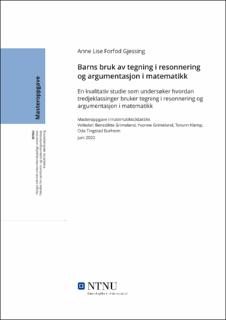| dc.contributor.advisor | Grimeland, Benedikte | |
| dc.contributor.advisor | Grimeland, Yvonne | |
| dc.contributor.advisor | Klemp, Torunn | |
| dc.contributor.advisor | Burheim, Oda Tingstad | |
| dc.contributor.author | Gjessing, Anne Lise Forfod | |
| dc.date.accessioned | 2022-07-19T17:24:01Z | |
| dc.date.available | 2022-07-19T17:24:01Z | |
| dc.date.issued | 2022 | |
| dc.identifier | no.ntnu:inspera:107175740:30212574 | |
| dc.identifier.uri | https://hdl.handle.net/11250/3007099 | |
| dc.description.abstract | Studien setter søkelys på barns bruk av tegning i matematikk. Hensikten med studien er å si noe om hvordan elever på tredje trinn bruker tegning i resonnering og argumentasjon i matematikk. Studiens forskningsspørsmål er: hvordan bruker tredjeklassinger tegning i resonnering og argumentasjon i matematikk?
Den metodologiske tilnærmingen til oppgaven er kvalitativ. Studien består av observasjon og elevarbeid, samt samtale rundt barnas egenproduserte representasjoner. Åtte tredjeklassinger var deltakere i studien. Elevene løste åtte problemløsningsoppgaver. Det ble samlet inn totalt 21 elevtegninger og gjennomført fem samtaler, hvor det ble gjort lydopptak og transkripsjoner. I samtalen ble elevene stilt oppfølgingsspørsmål som hadde til hensikt å få elevene til å utdype og argumentere for sin løsning.
Med utgangspunkt i funn i datamaterialet ble det lagd passende kategorier, ut ifra allerede eksisterende teorier om barns bruk av tegning i problemløsning, utarbeidet av blant andre Saundry og Nicol (2006) og Dahl (2020). De ulike resonneringskategoriene som ble funnet i datamaterialet var tegning som informasjonsholder, konkretiseringsmateriale, utforskingsverktøy og telleverktøy. Når det kom til hvordan elevene brukte tegningen i argumentasjon, ble det tatt utgangspunkt i allerede eksisterende rammeverk, og derav Krummheuers (1995) rammeverk om argumentasjon. Det ble funnet to ulike måter tegningen fungerte på i argumentasjonen; tegning som startpunkt for argumentasjon, og tegning som direkte del av argumentasjon.
Resultatene mine viser at elevene brukte tegning både som et problemløsningsverktøy og som et kommunikasjonsverktøy. Hele 18 av 21 tegninger ble brukt aktivt under problemløsningen, som et verktøy for elevene i resonneringsprosessen. Elevene brukte tegningen til å visualisere sin tenkning, og kommunisere sin forståelse til andre. Elevene argumenterte med utgangspunkt i tegningen, enten ved at tegningen fungerte som et startpunkt for argumentasjon, eller ved at en del av tegningen fungerte som data, konklusjon, garanti eller akseptert kunnskap. Hele 15 av 18 argumentasjoner ble regnet som et fullverdig argument, og 11 av argumentasjonene inneholdt alle delene i argumentasjonsmodellen. Funnene mine viser at tegning har et stort potensial i matematikkundervisning og læring, da det er et nyttig verktøy både i problemløsning og kommunikasjon. | |
| dc.description.abstract | This MA thesis focuses on children’s use of drawing in mathematics. The purpose of the study is to say something about how third-grade students use self-produced representations in reasoning and argumentation in mathematics. The study’s research question is: how do third graders use drawing in reasoning and argumentation in mathematics?
A qualitative method was used. The study consists of observation and student work, as well as conversations around the children’s self-produced representations. Eight third graders were participants in the study. The students solved eight problem-solving tasks. A total of 21 student drawings were collected and five conversations were conducted, where audio recordings and transcripts were made. In the conversation, the students were asked follow-up questions that were intended to get the students to elaborate and justify their solution.
Based on the findings in data material, appropriate categories were created. These concerned already existing theories about children’s use of drawing in problem solving, developed, among others, by Saundry and Nicol (2006) and Dahl (2020). The reasoning categories found in the data material were drawing as information holders, concretization materials, exploration tools and counting tools. When it came to how the students used drawing in argumentation, the fundamental basis was already existing frameworks, hence the use of Krummheuers (1995) framework on argumentation. Drawing was used in the argument in two different ways: as a starting point for argumentation and as a direct part of argumentation.
The results show that the students used drawing both as a problem-solving tool and as a communication tool. During the problem-solving process, 18 of the 21 drawings were actively used as a tool for the students in the reasoning process. Students used the drawing to visualize their thinking and communicate their understanding to others. The students argued on the basis of the drawing, either in that the drawing functioned as a starting point for argumentation, or in that part of the drawing functioned as data, conclusion, guarantee or accepted knowledge. Eleven of the arguments contained all of the features of the argumentation model, and 15 of the 18 arguments were considered complete arguments. Drawing, as a useful tool in both problem solving and communication, has a lot of potential in mathematics teaching and learning, according to my findings. | |
| dc.language | nob | |
| dc.publisher | NTNU | |
| dc.title | Barns bruk av tegning i resonnering og argumentasjon i matematikk | |
| dc.type | Master thesis | |
